Radiators
Introduction
Radiators are now available in a variety of styles, ranging from traditional cast iron to contemporary aluminium, and even glass and stone, to suit any interior décor scheme.
Whatever style you choose, radiators all essentially work by heating the air that surrounds them via radiation and/or convection. The heat is carried around the radiator via a liquid medium, usually water, which itself is heated either by electricity (for self contained heaters) or via the central heating and hot water system.

If your radiators are to be connected to the central heating system, a suitable corrosion inhibitor must be added to the water. This additive significantly reduces the build up of scale and internal corrosion, thereby extending the life of your heating system. Ensure that you select a corrosion inhibitor that is suitable for the material of your radiators.
Steel panel convectors
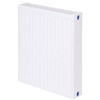
These radiators heat the air adjacent to them, causing it to rise and draw the cooler air beneath upwards to repeat the cycle.
Since this process relies on air in contact with the heated surface, steel panel convectors consist of one or two panels of corrugated steel to maximise the surface area.
Some designs of this radiator have ‘fins’, which heat the air mostly be convection, with just a little heat being radiated directly from the steel panel, to produce an even heat throughout the room. Radiators without ‘fins’ must rely on radiant heat which is less efficient and localised, and can cause cold areas in the room.
Modern radiators
Gone are the days when a radiator was just an ugly, functional lump of metal; central heating these days can even take the form of modern art…yes these really are radiators!
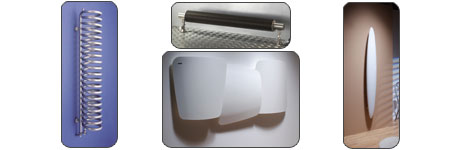
Refreshingly, radiators these days are available in a wide range of shapes, sizes, styles and colours, so you can use them to complement your interior design.
More recently, radiators have also started to be manufactured from new materials such as glass and stone, so while these are expensive alternatives at the moment, they certainly do have a certain ‘wow’ factor.
Glass radiators
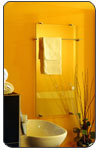
Glass radiators require no plumbing, instead using electrical elements that are invisibly built into the pane, rather like those used to defrost a car windscreen. Made from 13mm thick toughened safety glass, these radiators are completely transparent, can be wall or floor mounted and are available in a range of sizes.
Mirror radiators
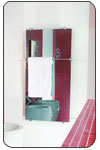
Mirror radiators take this application one step further and are perfect for a bathroom or kitchen where the heated surface prevents condensation from developing, so your mirror is never misted up.
Stone radiators
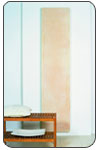
Stone radiators are made of marble, limestone or granite and make the most of the natural heat-retaining properties of stone. These radiators can use either electricity or they can be plumbed into your central heating system, where they use less water than a conventional radiator for the same heat output and are therefore more energy efficient.
Low surface temperature radiators
These were designed to adhere to the 1998 NHS Estates Guidance note that heating devices should not exceed 43°C, a standard which has now also been applied to local authorities and most commercial buildings. Despite these radiators clear commercial design, they are becoming increasingly popular in the home for use in childrens' bedrooms.
Cast Iron radiators
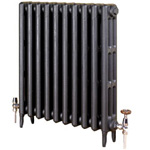
These traditional radiators heat the surrounding air in much the same way as those made from steel panels, and will work with any normal central heating system with British standards' fittings.
Cast iron is a very efficient emitter and retainer of heat, which allows these radiators to stay warm long after the central heating has been switched off, making them a cost-effective option. Keeping a home warm is partly about heating the fabric of the building, and because of their heat retention, cast iron radiators are becoming popular again to help the fabric of the building resist condensation and damp.
Additionally, their ‘old fashioned’ design is gaining favour again, so even new radiators can be found in this style while second -hand cast iron radiators can be found at reclamation yards.
Tubular towel rails
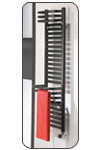
These are now widely available in a variety of colours and designs that provide a more aesthetic solution to heating a bathroom and warming/drying towels.
Fan assisted convectors

These units actively draw in cool air, heat it and expel the warm air. To do so, each unit includes a low volume fan which directs cool air over a heat exchanger, until a thermostat stops it when the desired temperature has been reached.
By forcing air movement this unit can heat a room quickly, however, as they require electricity to drive the fan (and in many cases power the heating element) they can be very expensive to run on a long term basis. Also, since the heat exchanger and fan are separately encased these units tend to be larger and more bulky than normal radiators.
Skirting heaters

These heaters work on the same principle as fan assisted convectors, but do not include a fan, so rely on air movement through convection to distribute heat. These heaters tend to have a low level output but since they are positioned round almost the whole perimeter of a room they do produce an even heat.
How powerful are my current radiators?
All radiators are rated according to their power output in kilo Watts (kW), if you are thinking of changes your existing radiators, then a good first step is to calcuate how powerful the existing radiators are.
If you feel that a room is currently far too cold, even when the radiator(s) are fully on, then consider adding a radiator a size or two larger than your current one(s).
Use the link below for power reference tables (kW) for the majority of common radiator sizes and designs:
Further information and useful links
- Find a Radiator Supplier near you
- Find a CORGI Registered Installer (corgi-gas-safety.com)
- Gas Regulations (odpm.gov.uk)
Site Pages
Featured Articles





